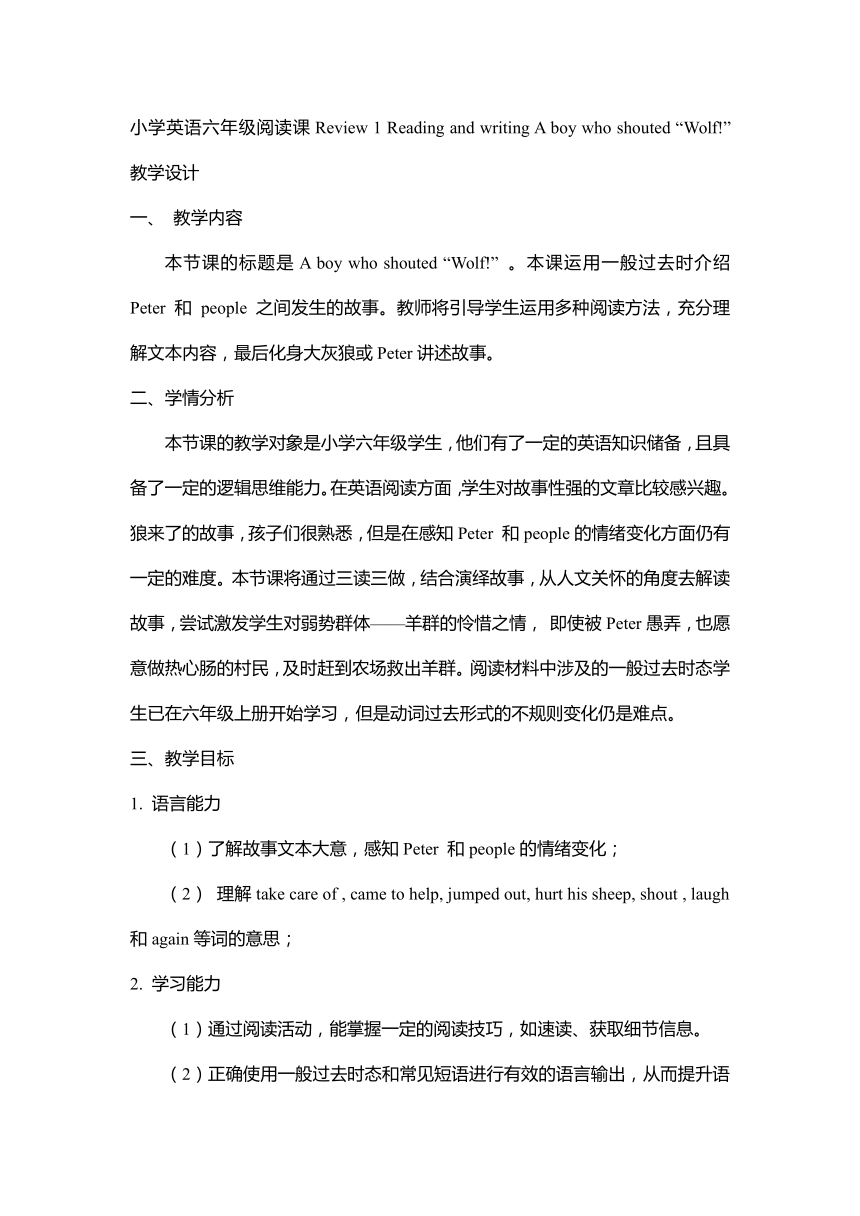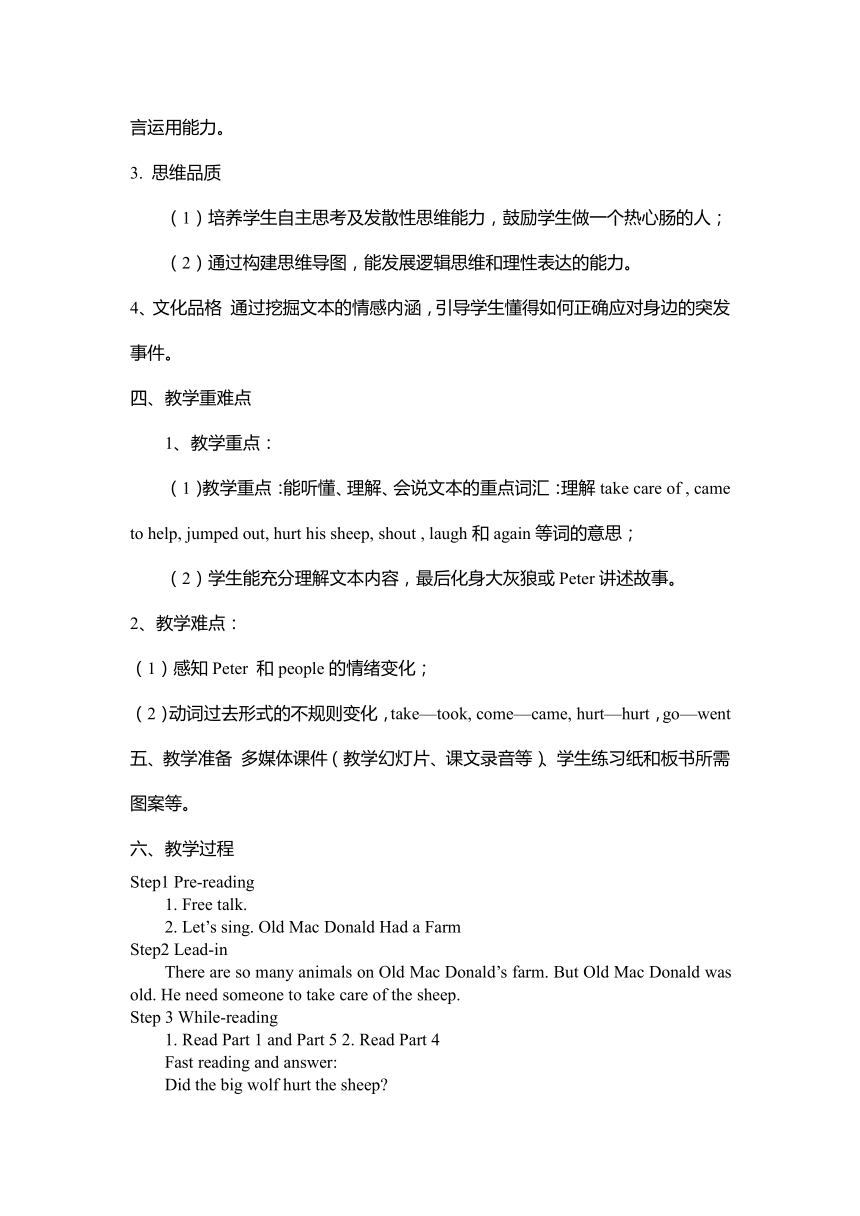广东版(开心英语)六年级下册 Review 1 Reading and writing A boy who shouted “Wolf!” 教案含反思
文档属性
| 名称 | 广东版(开心英语)六年级下册 Review 1 Reading and writing A boy who shouted “Wolf!” 教案含反思 |

|
|
| 格式 | docx | ||
| 文件大小 | 517.7KB | ||
| 资源类型 | 教案 | ||
| 版本资源 | 广东版 | ||
| 科目 | 英语 | ||
| 更新时间 | 2023-09-09 14:29:57 | ||
图片预览


文档简介
小学英语六年级阅读课Review 1 Reading and writing A boy who shouted “Wolf!”教学设计
一、 教学内容
本节课的标题是A boy who shouted “Wolf!” 。本课运用一般过去时介绍 Peter 和 people 之间发生的故事。教师将引导学生运用多种阅读方法,充分理解文本内容,最后化身大灰狼或Peter讲述故事。
二、学情分析
本节课的教学对象是小学六年级学生,他们有了一定的英语知识储备,且具备了一定的逻辑思维能力。在英语阅读方面,学生对故事性强的文章比较感兴趣。狼来了的故事,孩子们很熟悉,但是在感知Peter 和people的情绪变化方面仍有一定的难度。本节课将通过三读三做,结合演绎故事,从人文关怀的角度去解读故事,尝试激发学生对弱势群体——羊群的怜惜之情, 即使被Peter愚弄,也愿意做热心肠的村民,及时赶到农场救出羊群。阅读材料中涉及的一般过去时态学生已在六年级上册开始学习,但是动词过去形式的不规则变化仍是难点。
三、教学目标
1. 语言能力
(1)了解故事文本大意,感知Peter 和people的情绪变化;
(2) 理解take care of , came to help, jumped out, hurt his sheep, shout , laugh和again等词的意思;
2. 学习能力
(1)通过阅读活动,能掌握一定的阅读技巧,如速读、获取细节信息。
(2)正确使用一般过去时态和常见短语进行有效的语言输出,从而提升语言运用能力。
3. 思维品质
(1)培养学生自主思考及发散性思维能力,鼓励学生做一个热心肠的人;
(2)通过构建思维导图,能发展逻辑思维和理性表达的能力。
4、文化品格 通过挖掘文本的情感内涵,引导学生懂得如何正确应对身边的突发事件。
四、教学重难点
1、教学重点:
(1)教学重点:能听懂、理解、会说文本的重点词汇:理解take care of , came to help, jumped out, hurt his sheep, shout , laugh和again等词的意思;
(2)学生能充分理解文本内容,最后化身大灰狼或Peter讲述故事。
2、教学难点:
(1)感知Peter 和people的情绪变化;
(2)动词过去形式的不规则变化,take—took, come—came, hurt—hurt,go—went 五、教学准备 多媒体课件(教学幻灯片、课文录音等)、学生练习纸和板书所需图案等。
六、教学过程
Step1 Pre-reading
1. Free talk.
2. Let’s sing. Old Mac Donald Had a Farm
Step2 Lead-in
There are so many animals on Old Mac Donald’s farm. But Old Mac Donald was old. He need someone to take care of the sheep.
Step 3 While-reading
1. Read Part 1 and Part 5 2. Read Part 4
Fast reading and answer:
Did the big wolf hurt the sheep
Did Peter ask for help
What did Peter shout
2. Detailed reading:
1) Read Part 2-4 and answer How many times did Peter shout “wolf” Underline the sentences.
2) Read Part 2 and circle the key words At the first time, what happened when Peter shouted
3) Read Part 3 and circle the key words At the second time, what happened when Peter shouted
4) Read Part 3 and complete The people were cheated again.
5) Read Part 4 and circle the key words At the third time, what happened when Peter shouted
Step 4 Post-reading:
1. Listen to the story.
2. Fill in the blanks.
3. Retell the story. Students can choose Task1, be a big wolf and retell the story. They can also choose Task2, be Peter and retell the story. Use the mind map and fill in the blanks. Give a speech.
Some students can choose Task3, look at the pictures and write a story. They can get the paper from the teacher after class.
4. Let’s think. At last, nobody came to help. Why
5. Think and share. If you were one of the people there, would you come to help on the third day
6. Extension Write the story according to the key words.
七、板书设计
八、作业
1. Write the story according to the key words. (看图写小故事。 )
2. Retell the story to your parents.(讲故事给家长听。)
3. Read more,like The Horse and the Donkey.(读更多的伊索寓言。)
九、教学反思
本节课属于高年级阅读教学课。话题围绕牧羊人Peter三次喊狼来了展开。教师注重借助问题讲述故事情节:1 Did the wolf hurt the sheep 2 Did Peter ask for help 3 What did Peter shout 4 How many times did Peter shout “Wolf” 5What happened when Peter shouted Peter第一次、第二次和第三次喊狼来了,分别发生了什么?请学生圈出表示动作的单词,教师将每一个重要语言点都通过词条呈现在黑板上。 狼来了的故事,孩子们很熟悉。在阅读完Peter第二次喊狼来了的文段后,教师板书重点的动词。接着引导学生比较Peter第一次喊狼来了所用到相同的动词shouted和laughed(laughing), 用一句Peter did it again.来概括文段大意。然后,教师启发学生运用这个词来概括The people were cheated(欺骗)again . 这样不仅为后面的复述故事环节做好铺垫,更是帮助学生充分理解文本内容的“画龙点睛”之笔。 根据故事情节发展的特点,本节课的教学设计选用思维导图之一流程图。在“阅读中”这一阶段教师提出不同的问题,学生采用不同的阅读方法,如速读、细节阅读。教师在引导学生获取文本信息,理解文本内容的同时,还通过感知、体验等方式提升学生的思维能力。如Peter第三次喊狼来了的情绪是怎样的?教师自己扮演Peter喊狼来了,提问学生:“Peter is happy ” 有的学生能说出:“No,he is scared.” 教师接着请学生来扮演第三次喊狼来了的Peter,坐在座位上的学生念旁白。“阅读中”是一个多方面引导学生主动、积极思考的过程。 当然,本节课的教学也有需要改进的地方。由于录课现场学生一开始感到紧张,举手回答问题不够活跃,集体回答时才发现学生大部分都能找到表示动作的重点单词。此外,一些环节的教学设计还需要更加细致。
一、 教学内容
本节课的标题是A boy who shouted “Wolf!” 。本课运用一般过去时介绍 Peter 和 people 之间发生的故事。教师将引导学生运用多种阅读方法,充分理解文本内容,最后化身大灰狼或Peter讲述故事。
二、学情分析
本节课的教学对象是小学六年级学生,他们有了一定的英语知识储备,且具备了一定的逻辑思维能力。在英语阅读方面,学生对故事性强的文章比较感兴趣。狼来了的故事,孩子们很熟悉,但是在感知Peter 和people的情绪变化方面仍有一定的难度。本节课将通过三读三做,结合演绎故事,从人文关怀的角度去解读故事,尝试激发学生对弱势群体——羊群的怜惜之情, 即使被Peter愚弄,也愿意做热心肠的村民,及时赶到农场救出羊群。阅读材料中涉及的一般过去时态学生已在六年级上册开始学习,但是动词过去形式的不规则变化仍是难点。
三、教学目标
1. 语言能力
(1)了解故事文本大意,感知Peter 和people的情绪变化;
(2) 理解take care of , came to help, jumped out, hurt his sheep, shout , laugh和again等词的意思;
2. 学习能力
(1)通过阅读活动,能掌握一定的阅读技巧,如速读、获取细节信息。
(2)正确使用一般过去时态和常见短语进行有效的语言输出,从而提升语言运用能力。
3. 思维品质
(1)培养学生自主思考及发散性思维能力,鼓励学生做一个热心肠的人;
(2)通过构建思维导图,能发展逻辑思维和理性表达的能力。
4、文化品格 通过挖掘文本的情感内涵,引导学生懂得如何正确应对身边的突发事件。
四、教学重难点
1、教学重点:
(1)教学重点:能听懂、理解、会说文本的重点词汇:理解take care of , came to help, jumped out, hurt his sheep, shout , laugh和again等词的意思;
(2)学生能充分理解文本内容,最后化身大灰狼或Peter讲述故事。
2、教学难点:
(1)感知Peter 和people的情绪变化;
(2)动词过去形式的不规则变化,take—took, come—came, hurt—hurt,go—went 五、教学准备 多媒体课件(教学幻灯片、课文录音等)、学生练习纸和板书所需图案等。
六、教学过程
Step1 Pre-reading
1. Free talk.
2. Let’s sing. Old Mac Donald Had a Farm
Step2 Lead-in
There are so many animals on Old Mac Donald’s farm. But Old Mac Donald was old. He need someone to take care of the sheep.
Step 3 While-reading
1. Read Part 1 and Part 5 2. Read Part 4
Fast reading and answer:
Did the big wolf hurt the sheep
Did Peter ask for help
What did Peter shout
2. Detailed reading:
1) Read Part 2-4 and answer How many times did Peter shout “wolf” Underline the sentences.
2) Read Part 2 and circle the key words At the first time, what happened when Peter shouted
3) Read Part 3 and circle the key words At the second time, what happened when Peter shouted
4) Read Part 3 and complete The people were cheated again.
5) Read Part 4 and circle the key words At the third time, what happened when Peter shouted
Step 4 Post-reading:
1. Listen to the story.
2. Fill in the blanks.
3. Retell the story. Students can choose Task1, be a big wolf and retell the story. They can also choose Task2, be Peter and retell the story. Use the mind map and fill in the blanks. Give a speech.
Some students can choose Task3, look at the pictures and write a story. They can get the paper from the teacher after class.
4. Let’s think. At last, nobody came to help. Why
5. Think and share. If you were one of the people there, would you come to help on the third day
6. Extension Write the story according to the key words.
七、板书设计
八、作业
1. Write the story according to the key words. (看图写小故事。 )
2. Retell the story to your parents.(讲故事给家长听。)
3. Read more,like The Horse and the Donkey.(读更多的伊索寓言。)
九、教学反思
本节课属于高年级阅读教学课。话题围绕牧羊人Peter三次喊狼来了展开。教师注重借助问题讲述故事情节:1 Did the wolf hurt the sheep 2 Did Peter ask for help 3 What did Peter shout 4 How many times did Peter shout “Wolf” 5What happened when Peter shouted Peter第一次、第二次和第三次喊狼来了,分别发生了什么?请学生圈出表示动作的单词,教师将每一个重要语言点都通过词条呈现在黑板上。 狼来了的故事,孩子们很熟悉。在阅读完Peter第二次喊狼来了的文段后,教师板书重点的动词。接着引导学生比较Peter第一次喊狼来了所用到相同的动词shouted和laughed(laughing), 用一句Peter did it again.来概括文段大意。然后,教师启发学生运用这个词来概括The people were cheated(欺骗)again . 这样不仅为后面的复述故事环节做好铺垫,更是帮助学生充分理解文本内容的“画龙点睛”之笔。 根据故事情节发展的特点,本节课的教学设计选用思维导图之一流程图。在“阅读中”这一阶段教师提出不同的问题,学生采用不同的阅读方法,如速读、细节阅读。教师在引导学生获取文本信息,理解文本内容的同时,还通过感知、体验等方式提升学生的思维能力。如Peter第三次喊狼来了的情绪是怎样的?教师自己扮演Peter喊狼来了,提问学生:“Peter is happy ” 有的学生能说出:“No,he is scared.” 教师接着请学生来扮演第三次喊狼来了的Peter,坐在座位上的学生念旁白。“阅读中”是一个多方面引导学生主动、积极思考的过程。 当然,本节课的教学也有需要改进的地方。由于录课现场学生一开始感到紧张,举手回答问题不够活跃,集体回答时才发现学生大部分都能找到表示动作的重点单词。此外,一些环节的教学设计还需要更加细致。
